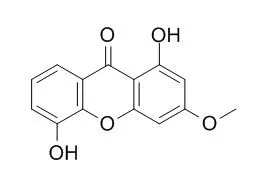| In vivo: |
| Indian J.Pharmacol., 1980,12(3):181-91. | | Anti-inflammatory and C.N.S. depressant activities of xanthones from Calophyllum inophyllum and Mesua ferrea[Reference: WebLink] |
The xanthones of Calophyllum inophyllum and Mesua Ferrea namely, dehydrocycloguanandin (DCG), calophyllin-B (CPB), jacareubin (JR), 6-desoxy jacareubin (DJR), Mesuaxanthone A (MXA), Mesuaxanthone B (MXB) and euxanthone (EX) were screened for various pharmacological effects in experimental animals.
METHODS AND RESULTS:
All the xanthones produced varying degrees of C.N.S. depression characterised by ptosis, sedation, decreased spontaneous motor activity, loss of muscle tone, potentiation of pentobarbitone sleeping time and ether anaerthesia in mice and rats.None of the xanthones had any analgesic, antipyretic and anticonvulsant activities. The xanthones did not produce any pharmacological effect in the cardiovascular system of frogs and dogs. All the xanthones exhibited anti inflammatory activity both by intraperitoneal and oral routes in rats as tested by carrageenin induced hind paw oedema, cotton pellet granuloma and granuloma pouch techniques, in normal and adrenalectomised rats.
CONCLUSIONS:
The xanthones did not have any mast cell membrane stabilising effect, and the degranulating effect of compound 48/80, diazoxide and Won-X-100 on rat peritoneal mast cells in vitro war not prevented. JR and DJR exhibited antiulcer activity in rats. The xanthones did not alter the prothrombin time in rats. |
|






 Cell. 2018 Jan 11;172(1-2):249-261.e12. doi: 10.1016/j.cell.2017.12.019.IF=36.216(2019)
Cell. 2018 Jan 11;172(1-2):249-261.e12. doi: 10.1016/j.cell.2017.12.019.IF=36.216(2019) Cell Metab. 2020 Mar 3;31(3):534-548.e5. doi: 10.1016/j.cmet.2020.01.002.IF=22.415(2019)
Cell Metab. 2020 Mar 3;31(3):534-548.e5. doi: 10.1016/j.cmet.2020.01.002.IF=22.415(2019) Mol Cell. 2017 Nov 16;68(4):673-685.e6. doi: 10.1016/j.molcel.2017.10.022.IF=14.548(2019)
Mol Cell. 2017 Nov 16;68(4):673-685.e6. doi: 10.1016/j.molcel.2017.10.022.IF=14.548(2019)